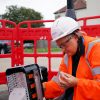AssetHUB Claims 100,000km of UK Fibre May be Left Underutilised

Asset reuse specialist AssetHUB has today claimed that an estimated 100,000km of publicly funded full fibre broadband cables in UK rural and hard to reach areas, allegedly worth over £1.4bn (total state aid), could be “left underutilised due to a lack of visibility” and “despite open networking being a condition of receiving taxpayers’ money“.
The aforementioned reference relates to the Government’s £5bn Project Gigabit broadband roll-out programme, which is being overseen by the Building Digital UK (BDUK) agency. But AssetHUB clams that some builders of related networks “could be failing to make their cables easily available to other operators” and thus “holding back plans to ‘level-up’ remote communities across the UK.”
The company is thus urging all network builders that have received funding through BDUK to make sure they know where their fibre is deployed and advise that this infrastructure is open for use by other companies. “BDUK provides public money for rural deployments that are mandated to provide wholesale access to passive, active, backhaul and dark fibre,” said AssetHUB, which is of course an area where they have a clear vested interest.
Advertisement
Rob Leenderts, CEO of AssetHUB, said:
“The UK Altnet industry is at a risk of more unnecessary overbuild as new entrants rush to deploy new infrastructure without considering the long-term sustainability of their business models. AssetHUB’s BDUK Project Gigabit-compliant trading platform for purchasing and selling infrastructure and services helps network builders map their fibre networks for visibility. It also makes sure approved ISPs and other network builders are aware and able to gain access to the network, securely, offering those that have not received funding an alternative to building more fibre.
For those network builders who have funded their own network buildouts, there is the added opportunity to generate some more revenue by selling space, services and unused fibre to other companies”.
On the one hand, it is true that those operators receiving state aid for related deployment contracts do face a wholesale obligation. On the other hand, making a commercial model for this is still down to the network operators’ and not every operator has seen fit to make the commercials attractive enough for others to use. But conflating the active and passive parts of this also makes for a rather more complex discussion, since they’re both very different sides of the same coin, where generalisations can cause confusion.
As for access at the infrastructure layer. Most alternative networks prefer to use Openreach’s existing cable ducts and poles, rather than that of other operators, because it is a regulated solution and one that has been reasonably well refined over many years.
Put another way, altnets tend to avoid building their own ducts and trenches where possible, which can make for quite a patchwork of infrastructure (awkward to harness). ISPreview explored the issues of infrastructure sharing in a bit more depth back in 2021 (here).
At this point it is important to remember that smaller alternative networks also carry much more financial risk than the established incumbents, which is often, but not always, reflected in the commercial models they come up with at wholesale. However, dedicated wholesale providers, such as CityFibre, do of course have more of an interest in making wholesale attractive, at least to retail ISPs.
Advertisement
Mark is a professional technology writer, IT consultant and computer engineer from Dorset (England), he also founded ISPreview in 1999 and enjoys analysing the latest telecoms and broadband developments. Find me on X (Twitter), Mastodon, Facebook, BlueSky, Threads.net and Linkedin.























































All that wasted material and money, along with all the wasted fibre cables where there’s 3 or 4 different networks running to the same street caused by different networks over building each other.
What a crazy system.
You’d think that in these modern times our government could come up with a better system, less wasteful and less disruptive, as different networks dig up the same road multiple times to lay their cables.
As per the article above, the reality is usually a bit more complex than that, as a lot of operators will overbuild by using Openreach’s existing ducts and poles where possible.
Even if they utilise existing ducting and/or poles, there will still be miles and miles of wasted fibre optic cable, some of which I guess will never be used.
@John It would be normal to pull say an eight core fibre (or even more) and then only use a single pair. The cost differential is tiny if anything and it gives you options down the line including in fault conditions. However in the meantime that fibre is sitting idle and is part of these figures which is somewhat meaningless.
Reply to Mark Jackson :- in Rugby there has been ductwork completed by BT/OR (Historic), VMO2, City Fibre, Gigabit(?); all who seemingly have provided their own ductwork one after another. Competition is all very well and good but when the provision of competition is anything up to 2 years of disruption to roadways and pavements it becomes a joke. Particularly when they are all providing to one street but completely ignoring the next.
As always the statement is from someone with a vested interest in what they are proposing and it ends up being an avert for their systems.
Should we all only have one gigabit option delivered by a sole network operator? That seems to be the perfect end goal to avoid waste.
That then means we lose any point of differentiation on the network and options for faster/cheaper services.
There’s probably not much difference in the actual fibre. An infrastructure that brought all fibres back to local patch points where operators could install their differentiating equipment and services would have a lot less waste.
They could call them exchanges. Have one per town……
There’s plenty of opportunity to differentiate on product and service even with a single last mile provider. The core network has a much bigger impact on the service offered than identical gpons offered by different companies.
The wholesale obligation was always going to be, in effect, optional. The regional contracts are huge and very few bidders have the financial clout to build them.
The government would have found it very difficult or impossible to add any kind of wholesaling mechanism to these contracts without putting off at least some of those bidders.
It is unsuprising they didn’t bother.
it’s also lip service at best. if even cityfibre is struggling to entice ISPs, some random tinpot altnet will never manage
not that this wasn’t foreseen. KCom had to follow all the same rules as BT around wholesale and LLU access, but in practice no one bothered because the cost/benefit was not there.
Trouble is that there are so many altnets with fragmented coverage it would be a tall order for an ISP to sign up with many (or all) of them when you have a single network (Openreach) covering the whole country with the prospect of VMO2/Nexfibre also providing wholesale services on the horizon. People in the altnet world must realise that if they want to compete against the established players then they need to consolidate into a large scale wholesale player to compete against the established players. The great consolidation that has long been touted really needs to gather some momentum, the sooner the better to give Openreach some much needed competition.
Where I live today I received a letter from City Fibre announcing they will be installing their ducts fibre to the village this quarter. To do that they are closing roads to put in new ducts as well as fibres as they are taking a different route to the BT/OR duct network. So not only are they digging up freshly renewed road surfaces we have to put with diversions that pass squeeze spots whilst those roads are closed.
Most of the village now has the option of BT FTTP of which is now in many houses it passes.
Will there be any benefit to the village residents? Just how many customers will they get? Maybe a few but not as many as they hope. I doubt they will be allowed onto the new housing estate that hasn’t had the roads adopted and if they can get into that estate I doubt anyone will buy the product as all the houses have BT/OR FTTP from new.
It’s always funny when ppl in office and never done anything manual in their lives looks at some stat and think they know stuff because they write some poxy report.
It is far more complicated and nothing like the report says. There’s always more fibre laid than is needed and companies like to keep spares. There might be a smidgen of truth but reports like this is pure toilet paper.
In the village where I live City Fibre have announced they will installing this quarter. They will be closing roads to install their ducts. Roads that have just been relaid and passing squeeze spots causing more hassle. The whole village has BT/OR FTTP in every road with a pretty high take-up so I seriously doubt they will see a return on their costs in this area.
More evidence that BDUK is a waste of taxpayers’ money.
Or a good idea, but done incompetently. Would have possibly been better to let the commercial build get further towards completion before decision what needed subsidy.